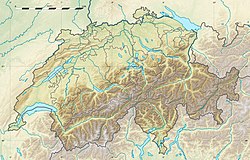| Besano Formation | |
|---|---|
| Stratigraphic range: Late Anisian (Illyrian)–Early Ladinian (Fassanian)[1] ~ | |
| Type | Geological formation |
| Underlies | San Giorgio Dolomite |
| Overlies | Lower San Salvatore Dolomite |
| Lithology | |
| Primary | Dolomite, shale |
| Location | |
| Coordinates | 45°54′N 8°54′E / 45.9°N 8.9°E |
| Approximate paleocoordinates | 7°30′N 21°00′E / 7.5°N 21.0°E |
| Region | Lombardy, Piedmont, Ticino |
| Country | Italy Switzerland |
| Extent | Southwestern Limestone Alps |
| Type section | |
| Named for | Besano |
The Besano Formation is a geological formation in the southern Alps of northwestern Italy and southern Switzerland. This formation, a thin but fossiliferous succession of dolomite and black shale, is famous for its preservation of Middle Triassic (Anisian–Ladinian) marine life including fish and aquatic reptiles. It is exposed in the Monte San Giorgio and Besano area. It is among the formations responsible for the area being designated as a UNESCO World Heritage Site. In Switzerland, it is also known as the Grenzbitumenzone.[2][3][1][4][5][6][7][8] The Anisian-Ladinian boundary lies in the upper part of the Besano Formation.[1]
- ^ a b c Furrer, Heinz (1995). "The Kalkschieferzone (Upper Meride Limestone, Ladinian) near Meride (Canton Ticino, Southern Switzerland) and the evolution of a Middle Triassic intraplatform basin". Eclogae Geologicae Helvetiae. 88 (3): 827–852.
- ^ Bernasconi, Stefano Michele (1991). Geochemical and microbial controls on dolomite formation and organic matter production/preservation in anoxic environments: a case study from the Middle Triassic Grenzbitumenzone, Southern Alps (Ticino, Switzerland). ETH Zurich Dissertation (Doctoral Thesis). pp. 1–198. doi:10.3929/ethz-a-000611458. hdl:20.500.11850/140499.
- ^ Bernasconi, S.; Riva, A. (1993). "15 - Organic Geochemistry and Depositional Environment of a Hydrocarbon Source Rock: the Middle Triassic Grenzbitumenzone Formation. Southern Alps. Italy/Switzerland.". In Spencer, A.M. (ed.). Generation. Accumulation and Production of Europe's Hydrocarbons III. European Association of Petroleum Geologists. pp. 179–190.
- ^ Röhl, H.J.; Schmid-Röhl, A.; Furrer, H.; Frimmel, A.; Oschmann, W.; L., Schwark (2001). "Microfacies, geochemistry and palaeoecology of the Middle Triassic Grenzbitumenzone from Monte San Giorgio (Canton Ticino, Switzerland)". Geologia Insubria. 6 (1): 1–13.
- ^ Etter, Walter (2002). "Monte San Giorgio: remarkable Triassic marine vertebrates". In Bottjer, D.J.; Etter, W.; Hagadorn, J.W.; Tang, C.M. (eds.). Exceptional fossil preservation; a unique view on the evolution of marine life. New York: Columbia University Press. pp. 220–242.
- ^ Stockar, Rudolf; Baumgartner, Peter O.; Condon, Daniel (15 May 2012). "Integrated Ladinian bio-chronostratigraphy and geochrononology of Monte San Giorgio (Southern Alps, Switzerland)" (PDF). Swiss Journal of Geosciences. 105 (1): 85–108. doi:10.1007/s00015-012-0093-5. ISSN 1661-8734. S2CID 129644478.
- ^ López-Arbarello, Adriana; Bürgin, Toni; Furrer, Heinz; Stockar, Rudolf (2016-07-19). "New holostean fishes (Actinopterygii: Neopterygii) from the Middle Triassic of the Monte San Giorgio (Canton Ticino, Switzerland)". PeerJ. 4: e2234. doi:10.7717/peerj.2234. ISSN 2167-8359. PMC 4957996. PMID 27547543.
- ^ Rieppel, Olivier (2019). Mesozoic Sea Dragons: Triassic Marine Life from the Ancient Tropical Lagoon of Monte San Giorgio. Bloomington, IN: Indiana University Press. doi:10.2307/j.ctvd58t86. ISBN 978-0-253-04013-8. JSTOR j.ctvd58t86.
